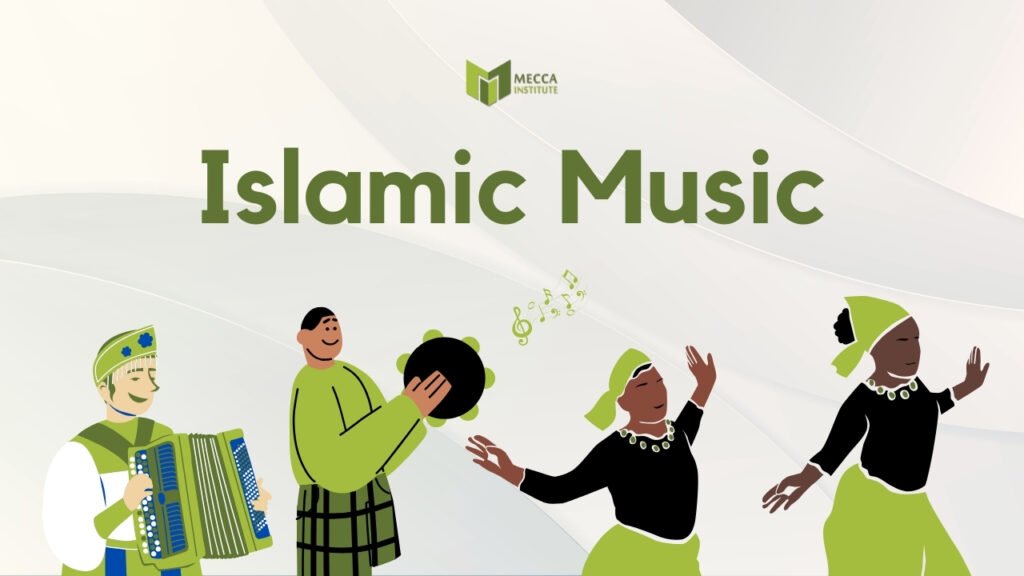Islamic music is diverse, says Imam Daayiee Abdullah, noting that its spiritual and cultural contributions have made a difference.
Islamic scholars have traditionally differed in their views on music, just as they differed on food or even worship. Today, some believe it should be avoided as it can lead to sin and distraction from worship.
Some of these scholars say the soul should instead focus on remembrance of God. Others argue music itself is not haram if it doesn’t promote haram ideas or detach the heart from remembering God.
In Progressive Islam, we do not dictate how members of our community live their lives, including whether they incorporate music into their lives or not.
That said, even the staunched critics of music do not deny there is “some” singing. For example, there are authentic hadiths from the collection of Muslim that say melodizing the Quran recitation is recommended.
Of course, music is a big part of Islamic culture. In this guide, I will describe the many aspects of Islamic music.
Music in Islam
The general consensus among both Sunni and Shia scholars is that music is haram. The reasons they cite tend to focus on its potential to lead to sinful behavior, distractions from worship, and the promotion of immoral values.
At the same time, both of them have hadiths that encourage melodizing the Quran through the use of beautiful recitation known as “Tajwid” (تجويد). These are the types of melodies you hear when people recite the Quran.
In the Middle East, they take things further. There is such a thing as Taghanni or “singing the Qur’an” (تغني بالقرآن). This is very popular, and there are many fatwas that say it is alright.
According to Sunni scholars, Prophet Muhammad stressed the importance of reciting the Quran with a melodious voice. These hadiths, therefore, say that he did so as a way of promoting a heartfelt connection with the scripture.
In that case, you could say that they are not saying “all” music is haram.
Meanwhile, music in Sunnism and Shi’ism is not limited to the beautiful, melodic recitations of the Quran. There is also the Adhan (أَذَان) or call to prayer.
Likewise, there is the Nasheed (نَشِيد), accapella-style singing. Like Tajwid and Adhan, Nasheed is very popular among traditional Muslims.
Nasheed is Islamic vocal music or chants, often a cappella. The lyrics celebrate Islamic teachings, history, and virtues. Traditional Muslims believe it promotes spiritual reflection and devotion.
Finally, music is a big part of Islam, even if some traditional scholars say it isn’t. There are also instruments, including drums, tambourines, cymbals, wind instruments, and more.
Music has been a big part of Islam, especially within Sufism, since the beginning, and it is a diverse art form, as you will see in the rest of this guide.
Islamic Music Instruments

Islamic music features a diverse range of instruments. These include the drums, tambourines, and cymbals. Drums produce rhythmic beats, tambourines add a lively jingle, and cymbals are used for accentuating melodies.
Tambourines, for example, are used in weddings in the Middle East to add a lively element to the festivities. In many cultures, they are played by women during the wedding celebrations, often accompanied by ululations.
Meanwhile, wind instruments like flutes, clarinets, horns, and trumpets contribute melodious tunes. These instruments produce melodious tunes through the vibration of air.
The ney, for example, occupies an especially important role in the music of the Mevlevi order of Sufis. Ceremonies often feature the haunting sounds of the ney, which is believed to represent the longing of the human soul for union with God.
Finally, stringed instruments like the oud create rich sounds. The oud (عود) is fretless and produces a unique, instantly recognizable sound, often used in traditional and contemporary Islamic music.
The oud has inspired many more, including the barbat (Iran), laouto (Cyprus), and dambus (Indonesia).
So, together, these instruments create diverse music across Islamic culture. They enrich music with a blend of rhythms, melodies, and cultural influences.
Islamic Music Genres
Islamic music includes a diverse range of genres. Each genre has its own cultural significance, especially outside of the Arabic-speaking region.
Some of the major Islamic music genres include Taghanni, Adhan, Dhikr, Nasheed, Gnawa, Qawwali, and Nasyid.
Since Taghanni and Adhan have already been discussed in this guide, let’s start with dhikr. Dhikr is the recitation of a holy name or phrase, often set to rhythm.
Although dhikr is part of most denominations, it is most common within Sufism. In Sufism, dhikr is used to cultivate awareness of and devotion to God.
Dhikr can be performed silenty, in a whisper, or loudly. It can be within a group context, as well, which means it can be silent, whisper, or loudly chanted.
Nasheed, on the other hand, is vocal. These are vocal songs that praise Allah, celebrate faith, and honor Islamic figures, often performed without instruments.
Although Taghanni, Adhan, Dhikr, and Nasheed are cross-cultural Islamic music genres, there are some that are unique to particular places. Qawwali, for example, is an Islamic devotional music practiced in South Asia.
Likewise, Nasyid in the Malay Archipelago and Kanawah in North Africa are also integral to Islamic musical traditions.
Sometimes, a particular genre is only important to a specific group. Kanawah (ڭْناوة), called Gnawa in Morocco, Diwan in Algeria, and Stambali in Tunisia, is a musical tradition rooted in West Africa’s Hausa culture.
These North African cultures are mostly Arab and Berber groups, but the Hausa were brought to the regions centuries ago when they were enslaved. As a result, they are a small minority in each of these societies.
Finally, Islamic music genres serve as expressions of devotion, spirituality, and cultural identity within the diverse Muslim community.
Culture in Islamic Music

Islamic music has a global presence because of the diverse cultural and ethnic backgrounds of Muslims. As a result, indigenous traditions have influenced the musical styles popular among Muslims today.
The multi-ethnic nature of Islam has led to a vast array of musical expressions, expressing the diversity of spirituality across continents. For example, Hadrah and Qawwali are both popular Sufi genres in their cultures, but they are very different from one another.
Hadrah may feature one or two instruments, whereas a Qawwali performance may require anywhere from five to ten instruments. And where lyrics are more important in Hadrah, the vibe is more important in Qawwali.
Meanwhile, there is an incorporation of elements from various musical traditions. For example, Maulidi ya Homu, a popular Swahili Sufi genre, uses movements, including synchronization, to achieve a spiritual state or “hal” (حَال). The synchronization of the movement to the group is what creates unity, which symbolizes unity with the Divine.
The Rifaʽiyya Sufis of Zanzibar use local instruments of the larger Taraab genre of Swahili music like percussion and human vocals, often led by the sheikh of the group.
On the other hand, the Mehlevi Sema, a popular Turkish Sufi genre, uses movement, including whirling, to detach from the world. The eyes may remain open, but it’s through the blurring of the world that creates an opportunity to listen or “sama” (سَمْع) to the messages of the heart that are from the Divine. They use instruments like the ney to achieve their goal, where they remain silent or silently chant.
Finally, culture is how Muslims connect to God in general. From the way they pray to how they eat, Muslims use culture to help them get closer to God. Naturally, music isn’t any different.
Muslim Musicians
Like genres, Muslim musicians are diverse. In many modern Muslim societies, where secular music outperforms spiritual genres, some of these musicians stand out.
Mehdi Qamoum, for example, is a Moroccan singer in the Kanawah (gnawa) genre. He has performed all over the world at festivals, and so on.
In Turkey, Mercan Dede has crafted for himself a large and unique following. His Mevlavi Sufi-inspired music is at once global and very local. Over the years, he collaborated with musicians all over the world.
Abida Parveen has proved women can take center stage with music. Her qawwali songs are not only popular in her home country of Pakistan but around the world. She is considered one of the greatest qawwali performers of all time.
In nearby India, the Nooran Sisters group made huge waves in recent years when one of their songs trended on social media. The powerful vocals timed to the music made it possible to become one of the most popular memes in all of Asia.
The late Ahmad Al-Tuni became a prominent musician in his home country of Egypt before becoming a global success. His music was featured in Spain and elsewhere.
In the United States, Malaysian-born singer Ani Zonneveld, a member of our Progressive Muslim community, has done a fantastic job with her Islamic music. She has performed across the United States and the world.
Muslim musicians inspire us, help us get closer to God, and sometimes push the envelope. Their contribution to our communities is highly appreciated.
Conclusion
Music in Islam is a reflection of the diverse heritage of the faith. With diverse genres such as Nasheed, Qawwali, and Kanawah embodying spiritual and cultural expressions, it continues to be a living aspect of the Islamic faith.
While some interpretations caution against certain instruments, both vocals and instruments remain integral to religious and social musical practices.
In Progressive Islam, we love music and welcome all, even those who don’t want to have music in their lives.
May Allah continue to guide us all.
Imam Daayiee Abdullah is the Executive Director of MECCA Institute and the author of “Progressive Islam,” a historic book that defines Progressive Islam.

